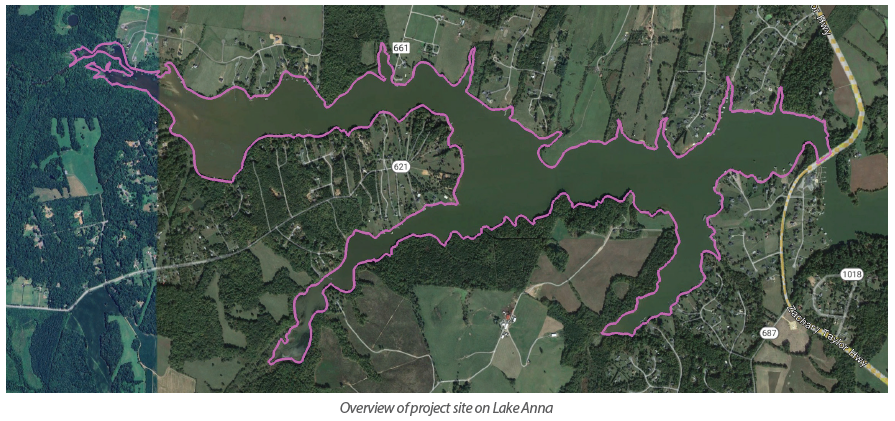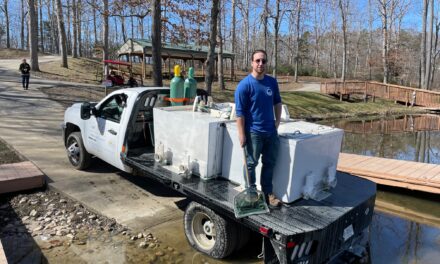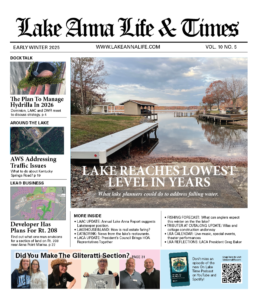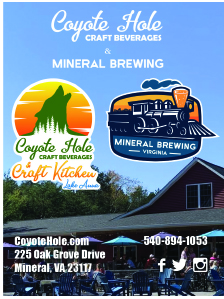Lake Anna is a 13,000-acre lake located in Virginia that was created in the 1970’s as a source of cooling water for the Dominion Energy North Anna Power Station. Since 2018, harmful algal blooms (HABs) have occurred in the upper reaches of the public side of Lake Anna, which degrade water quality, produce toxins that are a risk to humans and wildlife, and have negative impacts on recreation, property values, and the local economy. Legacy nutrients in the lake sediment and concentrated inflows of phosphorus are a key driver of HABs in Lake Anna.
The lake is an extremely important resource to the region and a focal point for recreation, and it is critical to restore the compromised water quality for the citizens that enjoy the lake.
The Lake Anna Advisory Committee (LAAC) has spearheaded an $822,000 phosphorus mitigation project to start addressing these phosphorus issues. EutroPHIX, a division of SePRO Corporation, and SOLitude Lake Management have been selected through a proposal process to undertake this project. The project scope includes the application of phosphorus inactivating products both directly to the North Anna tributary of Lake Anna, as well as to the North Anna River upstream of the lake to mitigate ongoing phosphorus inputs.
The long-term goal of the project is to improve water quality in Lake Anna and help mitigate the source of harmful algae blooms. The project’s funding was secured through a Virginia General Assembly FY24 appropriation (HB6001, Chapter 1, Item 374.U). The state funding went to the Department of Conservation and Recreation (DCR) and was then transferred to Louisa County for execution by the LAAC.
The project is currently in Phase 1 of a multi-year restoration plan for the northern end of Lake Anna. Six hundred acres of the North Anna Arm were treated with EutroSORB® G in late June to mitigate available sediment phosphorus. Additionally, a treatment system has been installed on the river upstream of the lake that is injecting Eutro- SORB® WC into the North Anna River to permanently bind soluble phosphorus before entering Lake Anna. This injection will be ongoing until the fall of 2024.
Because the flow of water in the North Anna River has been so low this summer due to the lack of rainfall, the volume of EutroSORB WC that is being injected into the river and delivered to the lake is not mitigating the desired quantity of phosphorus to demonstrate adequate short-term improvement in the water quality.
To accelerate the project goals and to ensure that the specified quantity of EutroSORB is delivered to the lake, the product will also be applied directly to the lake utilizing spray equipment specially designed for this type of treatment.
There will be two separate applications in the coming weeks – the first is planned for August 15th with a second, follow-up treatment planned for August 26th. These dates are subject to weather and lake conditions.
The active ingredients of the EutroSORB products are rare earth minerals that rapidly and permanently bind phosphorus from water and sediment. The products have a wide margin of safety for aquatic organisms, fish, birds, mammals, and humans, and the treatments have been reviewed and approved by Dominion Energy.
This project is being meticulously monitored to determine the amount of improvement in water quality and effectiveness of the treatments. There will be ongoing monthly water sampling of the North Anna Arm of Lake Anna along with collection of lake sediments in the fall.
Changes in the algae community will also be monitored throughout the project with the expectation there will be a reduction in HAB extent and severity. Results from this project will be used to inform future lake management actions taken at Lake Anna.
It is hoped that this project will provide an immediate water quality benefit to northern Lake Anna, and the LAAC is currently seeking funding for implementation in future years. This project can provide a tremendous benefit to the local community by improving recreation, supporting growth of the local economy, and protecting this valuable resource and downstream uses of water.
























